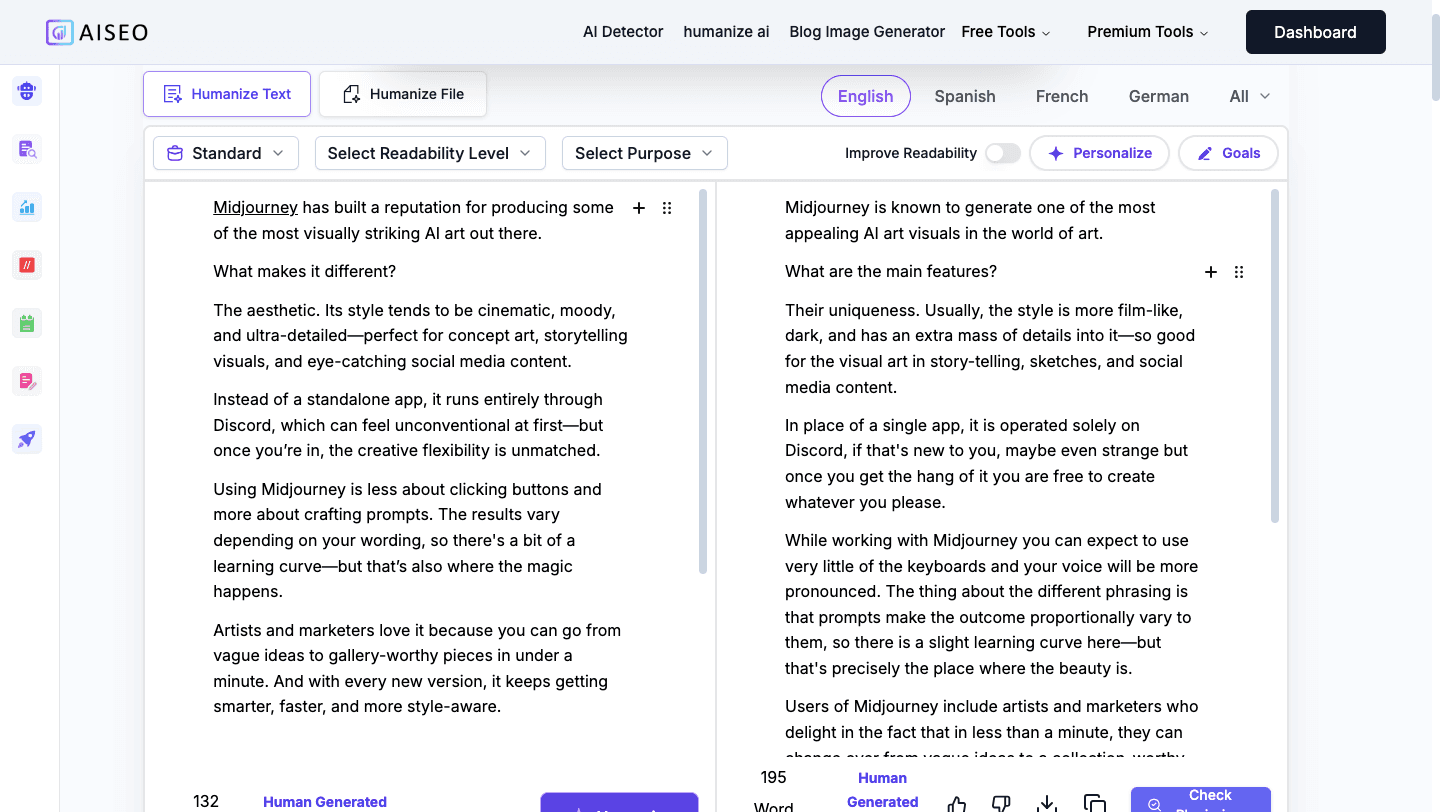Creating content consistently can feel overwhelming — especially when you're racing against deadlines and creative blocks.
That’s why many marketers turn to article rewriters as a way to repurpose existing content or overcome writer’s block. But here’s the challenge: not all rewritten content meets the mark for originality, clarity, or value.
If you want to create content with an article rewriter and still rank well, the process needs to be thoughtful, not automatic.
In this blog, you will learn:
- How to use an article rewriter without producing robotic, repetitive content
- Why editing and originality matter more than the tool you choose
- How to rewrite content that keeps readers engaged and satisfies SEO guidelines
Let’s break down exactly how to turn AI-generated rewrites into polished, valuable content.
1. Understand What an Article Rewriter Can and Can’t Do
An article rewriter, especially an AI-powered one, is a tool designed to transform existing text into a new version by changing sentence structures, word choices, or phrasing. It’s not about copying or spinning content word-for-word. Instead, it’s about helping you reshape ideas into fresh, unique expressions.
Even the most capable rewriter tool has blind spots. It can’t fact-check, assess tone, or tailor a message to your audience’s pain points. It also doesn’t understand nuance, sarcasm, or voice the way a human writer does. Think of the output as a rough starting point, not something ready to publish.
When you rely too heavily on rewriters without editing for flow, structure, or relevance, the result is often thin content — something Google penalizes.
By understanding the role of this tool, you can use it more effectively: as a writing assistant, not a replacement for strategy or critical thinking.
2. Start with High-Quality Source Material
An article rewriter is only as good as the content you feed into it.
If the original material is vague, outdated, or poorly written, the rewritten version will reflect those flaws, no matter how advanced the tool is.
Before rewriting anything, take the time to gather strong reference material from credible sources. Aim for content that is accurate, recent, and relevant to your audience.
Simple tools like survey links or The QR Code generator can help you collect input in creative ways — for instance, placing scannable codes on printed materials, social posts, or event booths to lead users to feedback form.
Avoid thin blog posts or anything that’s already been spun multiple times. The more thoughtful the source, the more valuable your rewritten content will be.
This step also reduces the risk of accidental duplication. When you rely on high-quality inputs and rewrite thoughtfully, you’re far more likely to end up with plagiarism-free content that feels original and useful, not just reworded.
Think of this as setting the foundation. If it’s solid, the rest of your content will stand stronger.
3. Use Rewriting Tools as a Starting Point, Not the Final Draft
AI-powered tools can save time, but they’re not meant to replace the writing process entirely.
Whether you’re using a free article spinner tool or a more advanced platform like the AISEO article rewriter, the key is to treat the output as a rough draft — not a publish-ready piece.

The value of these tools lies in their ability to rephrase quickly and spark new directions for your content. But that’s only the beginning. A human editor is still essential for adding transitions, improving clarity, and adapting the tone to match your audience’s expectations.
One of the most overlooked content rewriting tips is to read the rewritten article out loud. This exposes awkward phrasing, missed context, or robotic language that an AI can’t catch.
Your role is to bring clarity, flow, and purpose to the draft, turning AI output into something people actually want to read.
4. Edit Strategically for SEO and Readability
Using an article rewriter can speed up your workflow, but to turn that raw output into something rank-worthy and reader-friendly, editing is non-negotiable. This is where you shape content that not only sounds natural but also satisfies search intent and SEO algorithms.
Readable content ranks higher because it improves user experience and reduces bounce rates — two factors Google’s algorithm pays close attention to.
Here’s how to take your rewritten draft from acceptable to exceptional:
- Use clear, keyword-supported headings: Each section should answer a specific reader's question and reflect your primary or secondary keywords.
- Trim the excess, highlight the value: Remove repetitive or generic phrasing. Every sentence should add clarity or insight, not fluff.
- Format for how people read online: Use bullet points, short paragraphs, and scannable layouts to keep readers engaged.
- Refine the tone and transitions: Rewritten content can feel mechanical or disjointed. Smooth it out with natural connectors and a consistent voice.
- Be intentional with keywords: Place your primary keyword strategically (intro, subheading, conclusion) and fit in secondary keywords only when they feel natural to the reader.
These are the same principles taught in the best SEO course curriculums today—because strong editing bridges the gap between what your tool creates and what your audience and Google want to see. This step isn’t just polish; it’s performance.
5. Verify Originality and Quality Before Publishing
Even the most polished draft can fall short if it isn’t original or genuinely helpful.
That’s why the final step in your content creation process should always be a careful check for both plagiarism and quality. Rewritten content can still look too much like the original if the tool only makes small changes.
Always run your draft through a trusted plagiarism checker to protect your site from duplication risks and potential penalties. Tools like Duplichecker make it easy to confirm that your content is 100% original before it goes live.
Once the draft is cleaned up, pause and review it with your reader in mind. Ask yourself:
“Does this post truly help the reader?”
“Is the information accurate, easy to follow, and aligned with the topic's intent?”
If it holds up on all fronts, it’s ready for your audience.
If not, invest the extra few minutes—it’s always worth it.
6. Know When Rewriting Isn’t Enough
Article rewriters are useful tools, but they’re not the answer for every type of content. Some pieces demand more than rephrasing; they require original thinking, fresh insights, or firsthand experience that no tool can replicate.
For example, rewriting someone else's ideas won't cut it if you're writing a case study, opinion piece, or anything that speaks directly to your brand’s authority. These content types require unique research, expert input, and a distinct point of view that can’t be generated automatically.
Even highly technical or data-driven content often needs to be built from scratch to ensure accuracy and relevance.
Rewriting works best when you're updating existing content, repurposing evergreen topics, or consolidating ideas from multiple sources. But knowing when to set the tool aside and write something original is what truly sets high-performing content apart.
In short, article rewriting is a technique, not a content strategy. Use it wisely, and always aim for depth over shortcuts.
Final Thoughts
Creating content with an article rewriter doesn’t mean sacrificing quality, but it does require strategy, editing, and intention. The most successful content marketers know that tools are only as effective as the process behind them.
To recap, you’ve learned how to:
- Choose the right source material for better rewrites
- Edit for clarity, SEO, and readability
- Verify originality and know when rewriting won’t be enough
When you create content with an article rewriter the right way, you can scale your output without losing credibility or audience trust.
That said, many article rewrites still carry detectable patterns of AI-generated content — something search engines and discerning readers are increasingly sensitive to.
If you're looking to smooth out those signals and make your rewritten content feel more natural, tools like the AISEO AI Humanizer can help bridge that gap. It's designed to refine AI-generated text so it reads more fluidly, like something written by a real human, not a machine.

About Dilyar Buzan
Founder & CEO at AISEO
Artificial Intelligence - University of Amsterdam
LLM engineer
